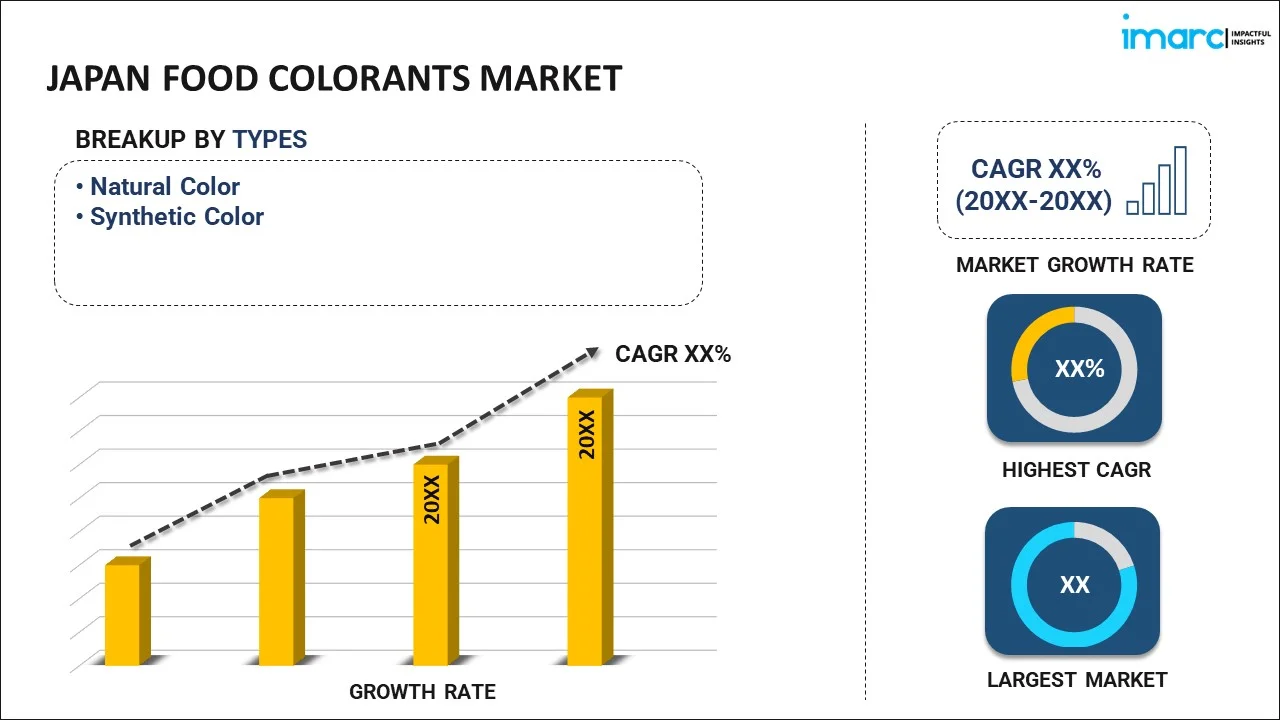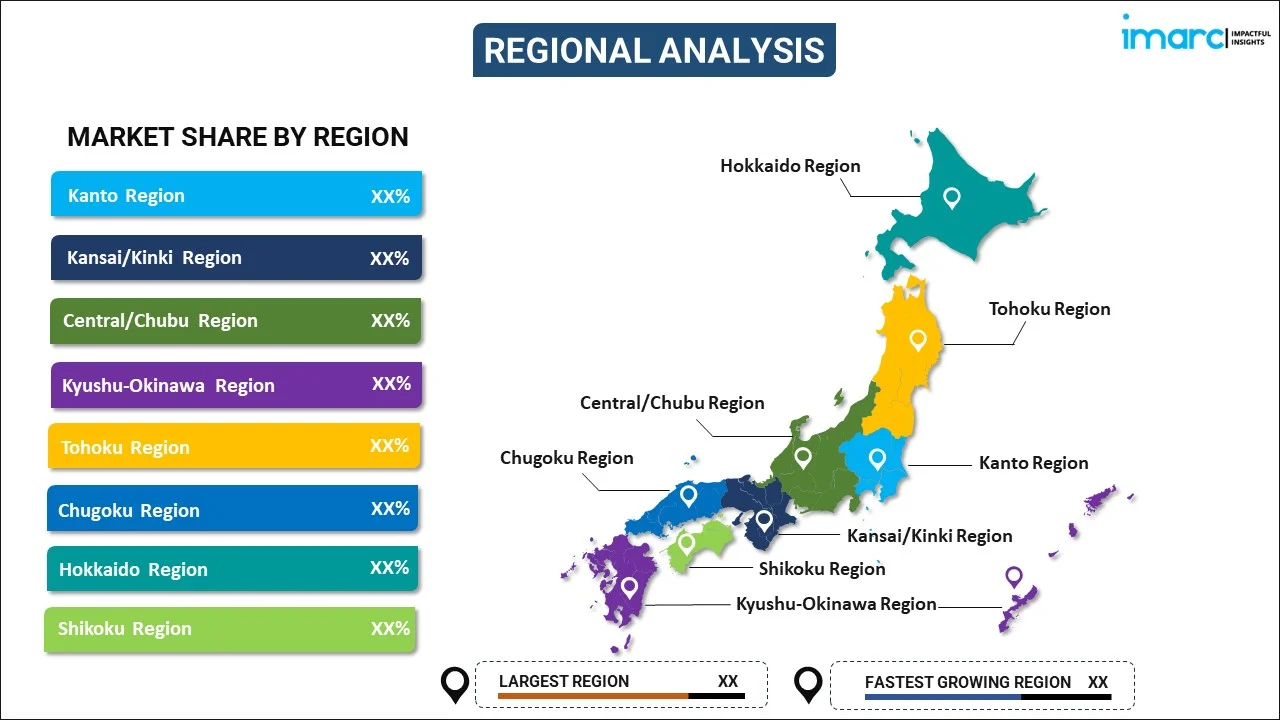
Japan Food Colorants Market Report by Type (Natural Color, Synthetic Color), Application (Beverages, Dairy and Frozen Products, Bakery, Meat, Poultry, and Seafood, Confectionery, Oil and Fats, and Others), and Region 2025-2033
Market Overview:
Japan food colorants market size reached USD 226.8 Million in 2024. Looking forward, IMARC Group expects the market to reach USD 373.5 Million by 2033, exhibiting a growth rate (CAGR) of 5.3% during 2025-2033. The increasing growth of food and beverage industry, coupled with the escalating consumer demand for enhancing the visual appeal and marketability of products, is primarily driving the market.
|
Report Attribute
|
Key Statistics
|
|---|---|
|
Base Year
|
2024
|
|
Forecast Years
|
2025-2033
|
|
Historical Years
|
2019-2024
|
| Market Size in 2024 | USD 226.8 Million |
| Market Forecast in 2033 | USD 373.5 Million |
| Market Growth Rate 2025-2033 | 5.3% |
Food colorants, also known as food dyes or food additives, are substances added to food and beverages to impart or enhance their color. These additives serve several purposes in the food industry. First and foremost, they make products more visually appealing, enticing consumers to purchase and consume them. Food colorants can also compensate for color loss during processing, storage, or exposure to light, ensuring that the final product retains its intended hue. There are two main types of food colorants: natural and synthetic. Natural colorants are derived from plants, minerals, or insects and include options like beet juice (red), turmeric (yellow), and spirulina (blue-green). Synthetic colorants are chemically manufactured and offer a wider range of vibrant colors. Regulatory agencies, such as the FDA in the United States, closely monitor and approve food additives for safety and use in specific applications. Food colorants play a crucial role in the aesthetics and marketability of many food products while adhering to strict safety guidelines to protect consumer health.
Japan Food Colorants Market Trends:
The food colorants market in Japan is experiencing robust growth due to several key market drivers. Firstly, consumer demand for visually appealing and aesthetically pleasing food products remains a primary catalyst. Furthermore, as consumers become increasingly health-conscious, the preference for natural and organic food colorants is on the rise, propelling the market forward. Additionally, the food industry's constant innovation and product differentiation strategies rely heavily on food colorants to create unique and attractive offerings. Moreover, the regional trend towards convenience foods, including ready-to-eat and processed items, fuels the demand for food colorants as these products often require vibrant colors to enhance their appeal. Apart from this, the expanding bakery and confectionery sector, coupled with the growing popularity of specialty and gourmet foods, contributes significantly to the market's growth. Furthermore, stringent food safety regulations and the need for certified colorants are prompting manufacturers to invest in R&D, stimulating market growth. Lastly, the foodservice industry's proliferation and the rising popularity of food delivery services is expected to drive the food colorants market in Japan.
Japan Food colorants Market Segmentation:
IMARC Group provides an analysis of the key trends in each segment of the market, along with forecasts at the country level for 2025-2033. Our report has categorized the market based on type and application.
Type Insights:

- Natural Color
- Synthetic Color
The report has provided a detailed breakup and analysis of the market based on the type. This includes natural color and synthetic color.
Application Insights:
- Beverages
- Dairy and Frozen Products
- Bakery
- Meat, Poultry, and Seafood
- Confectionery
- Oils and Fats
- Others
A detailed breakup and analysis of the market based on the application have also been provided in the report. This includes beverages, dairy and frozen products, bakery, meat, poultry, and seafood, confectionery, oils and fats, and others.
Regional Insights:

- Kanto Region
- Kansai/Kinki Region
- Central/ Chubu Region
- Kyushu-Okinawa Region
- Tohoku Region
- Chugoku Region
- Hokkaido Region
- Shikoku Region
The report has also provided a comprehensive analysis of all the major regional markets, which include Kanto Region, Kansai/Kinki Region, Central/ Chubu Region, Kyushu-Okinawa Region, Tohoku Region, Chugoku Region, Hokkaido Region, and Shikoku Region.
Competitive Landscape:
The market research report has also provided a comprehensive analysis of the competitive landscape. Competitive analysis such as market structure, key player positioning, top winning strategies, competitive dashboard, and company evaluation quadrant has been covered in the report. Also, detailed profiles of all major companies have been provided.
Japan Food colorants Market Report Coverage:
| Report Features | Details |
|---|---|
| Base Year of the Analysis | 2024 |
| Historical Period | 2019-2024 |
| Forecast Period | 2025-2033 |
| Units | Million USD |
| Scope of the Report | Exploration of Historical Trends and Market Outlook, Industry Catalysts and Challenges, Segment-Wise Historical and Future Market Assessment:
|
| Types Covered | Natural Color, Synthetic Color |
| Applications Covered | Beverages, Dairy and Frozen Products, Bakery, Meat, Poultry, and Seafood, Confectionery, Oil and Fats, Others |
| Regions Covered | Kanto Region, Kansai/Kinki Region, Central/ Chubu Region, Kyushu-Okinawa Region, Tohoku Region, Chugoku Region, Hokkaido Region, Shikoku Region |
| Customization Scope | 10% Free Customization |
| Post-Sale Analyst Support | 9-11 Weeks |
| Delivery Format | PDF and Excel through Email (We can also provide the editable version of the report in PPT/Word format on special request) |
Key Questions Answered in This Report:
- How has the Japan food colorants market performed so far and how will it perform in the coming years?
- What has been the impact of COVID-19 on the Japan food colorants market?
- What is the breakup of the Japan food colorants market on the basis of type?
- What is the breakup of the Japan food colorants market on the basis of application?
- What are the various stages in the value chain of the Japan food colorants market?
- What are the key driving factors and challenges in the Japan food colorants?
- What is the structure of the Japan food colorants market and who are the key players?
- What is the degree of competition in the Japan food colorants market?
Key Benefits for Stakeholders:
- IMARC’s industry report offers a comprehensive quantitative analysis of various market segments, historical and current market trends, market forecasts, and dynamics of the Japan food colorants market from 2019-2033.
- The research report provides the latest information on the market drivers, challenges, and opportunities in the Japan food colorants market.
- Porter's five forces analysis assist stakeholders in assessing the impact of new entrants, competitive rivalry, supplier power, buyer power, and the threat of substitution. It helps stakeholders to analyze the level of competition within the Japan food colorants industry and its attractiveness.
- Competitive landscape allows stakeholders to understand their competitive environment and provides an insight into the current positions of key players in the market.
Need more help?
- Speak to our experienced analysts for insights on the current market scenarios.
- Include additional segments and countries to customize the report as per your requirement.
- Gain an unparalleled competitive advantage in your domain by understanding how to utilize the report and positively impacting your operations and revenue.
- For further assistance, please connect with our analysts.
 Inquire Before Buying
Inquire Before Buying
 Speak to an Analyst
Speak to an Analyst
 Request Brochure
Request Brochure
 Request Customization
Request Customization




.webp)




.webp)












